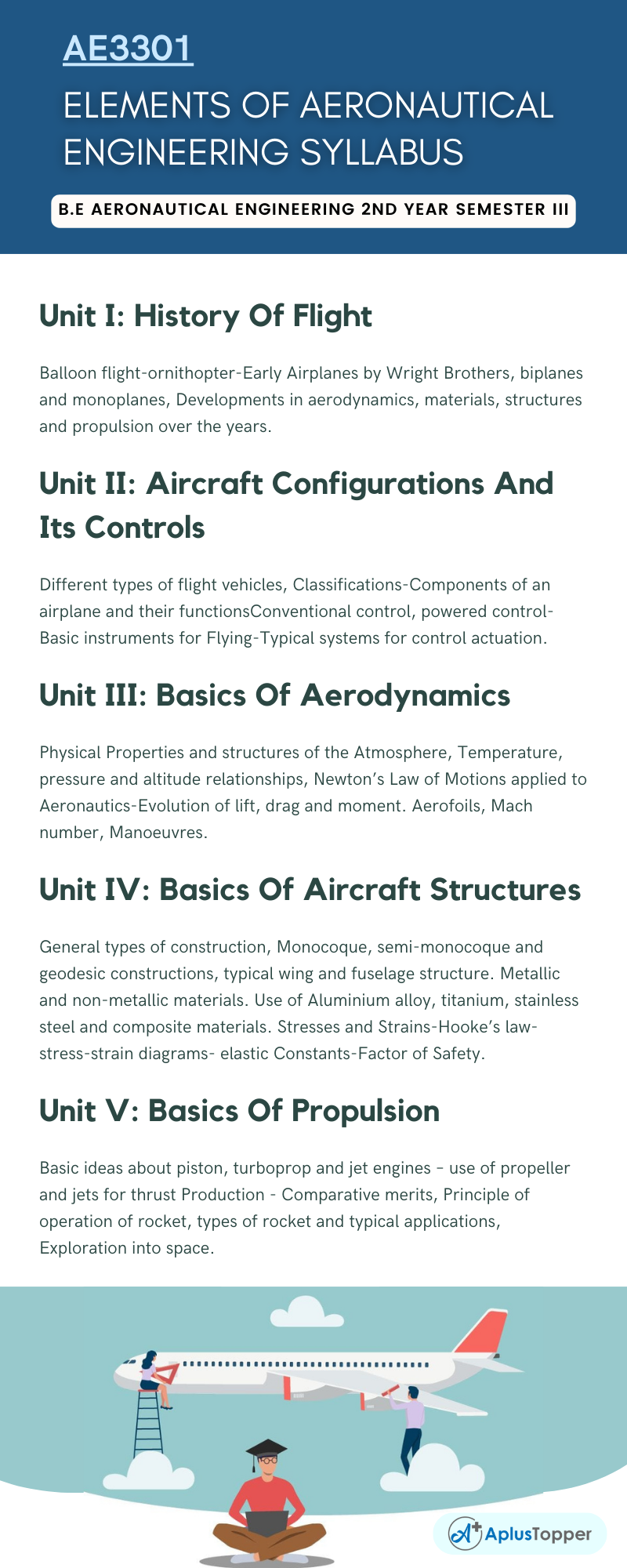Regulation 2021, Anna University Subject code – AE3301 deals with B.E Aeronautical Engineering 2nd year semester III Elements Of Aeronautical Engineering Syllabus. To prepare for challenging subjects in the field of Aeronautics need a detailed syllabus and preparation strategies. In this article, we discuss the Elements Of Aeronautical Engineering syllabus.
We intend to provide every topic of the syllabus and content required for academic performance, along with reference books. In this article, AE3301 – Elements Of Aeronautical Engineering Syllabus, you will be guided to get an idea of each topic of the syllabus and you can make your preparation strategy, and notes by filtering difficult topics from the different subjects. Then you can concentrate on the topic where you need to focus more. We included all the topics regarding the Aeronautical syllabus. We hope this information is useful to you. Don’t forget to share it with your friends and classmates.
If you want to know more about the syllabus of B.E Computer Science and Engineering connected to an affiliated institution’s under four-year undergraduate degree programme. We provide you with a detailed Year-wise, semester-wise, and Subject-wise syllabus in the following link B.E Aeronautical Engineering Syllabus Anna University, Regulation 2021.
Aim Of Concept:
- To acquire the knowledge on the Historical evaluation of Airplanes
- To learn the different component systems and functions
- To know the concepts of basic properties and principles behind the flight
- To learn the basics of different structures & construction
- To learn the various types of power plants used in aircrafts
AE3301- Elements Of Aeronautical Engineering Syllabus
Unit I: History Of Flight
Balloon flight-ornithopter-Early Airplanes by Wright Brothers, biplanes and monoplanes, Developments in aerodynamics, materials, structures and propulsion over the years.
Unit II: Aircraft Configurations And Its Controls
Different types of flight vehicles, Classifications-Components of an airplane and their functionsConventional control, powered control- Basic instruments for Flying-Typical systems for control actuation.
Unit III: Basics Of Aerodynamics
Physical Properties and structures of the Atmosphere, Temperature, pressure and altitude relationships, Newton’s Law of Motions applied to Aeronautics-Evolution of lift, drag and moment. Aerofoils, Mach number, Manoeuvres.
Unit IV: Basics Of Aircraft Structures
General types of construction, Monocoque, semi-monocoque and geodesic constructions, typical wing and fuselage structure. Metallic and non-metallic materials. Use of Aluminium alloy, titanium, stainless steel and composite materials. Stresses and Strains-Hooke’s law- stress-strain diagrams- elastic Constants-Factor of Safety.

Unit V: Basics Of Propulsion
Basic ideas about piston, turboprop and jet engines – use of propeller and jets for thrust Production – Comparative merits, Principle of operation of rocket, types of rocket and typical applications, Exploration into space.
Text Books:
- Anderson, J.D., Introduction to Flight, McGraw-Hill; 8th edition, 2015
- E Rathakrishnan, “Introduction to Aerospace Engineering: Basic Principles of Flight”, John Wiley, NJ, 2021
- Stephen.A. Brandt, Introduction to aeronautics: A design perspective, 2nd edition, AIAA Education Series, 2004.
References:
- Sadhu Singh, “Internal Combustion Engines and Gas Turbine”, SS Kataraia & Sons, 2015
- Kermode, “Flight without Formulae”, Pitman; 4th revised edition 1989.
Related Posts On Semester -III:
- MA3351 – Transforms and Partial Differential Equations
- AE3351 – Aero Engineering Thermodynamics
- AE3352 – Solid Mechanics
- CE3391 – Fluid Mechanics and Machinery
- AE3302 – Aircraft Systems and Instruments
